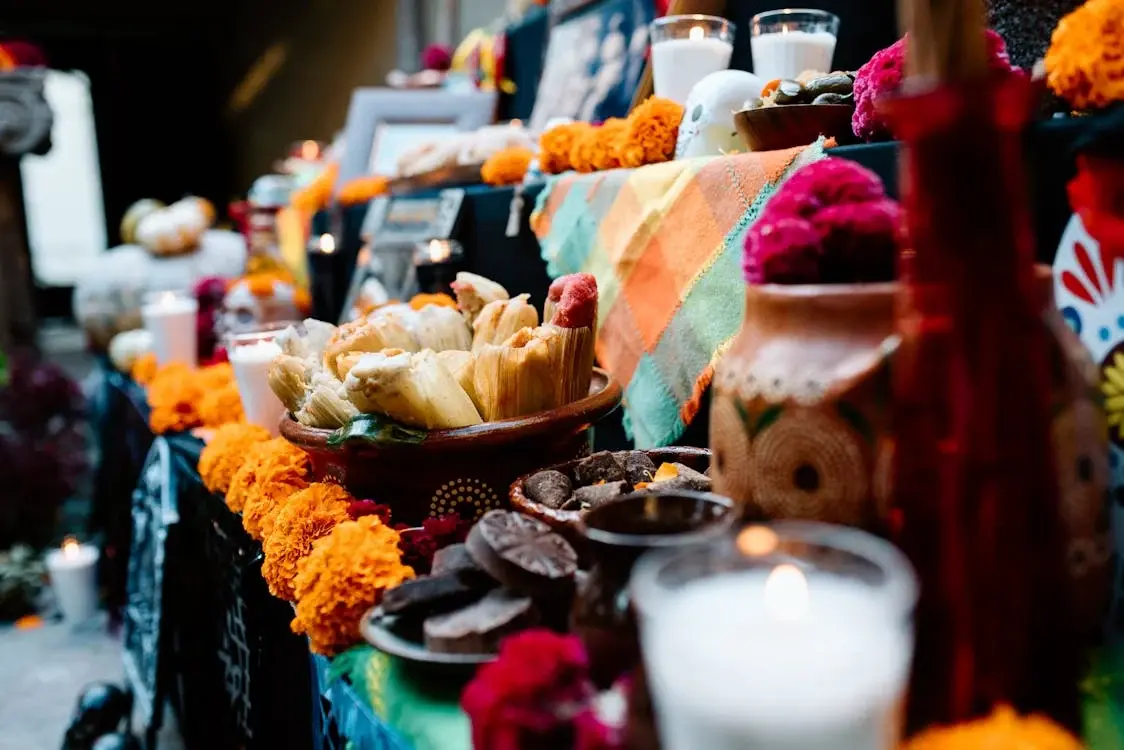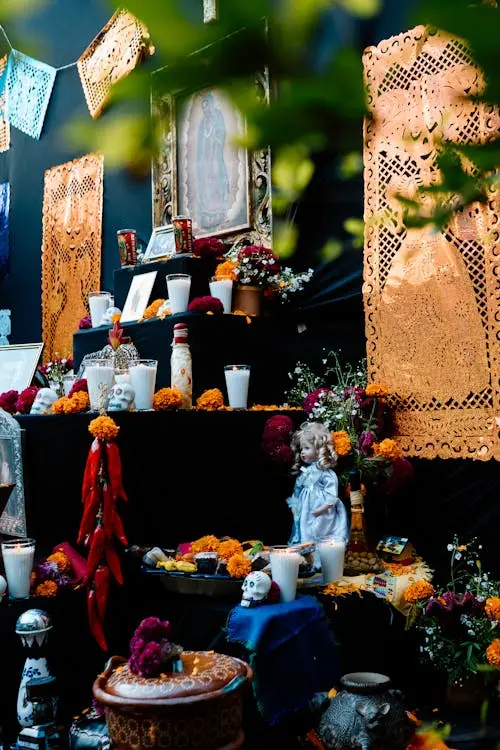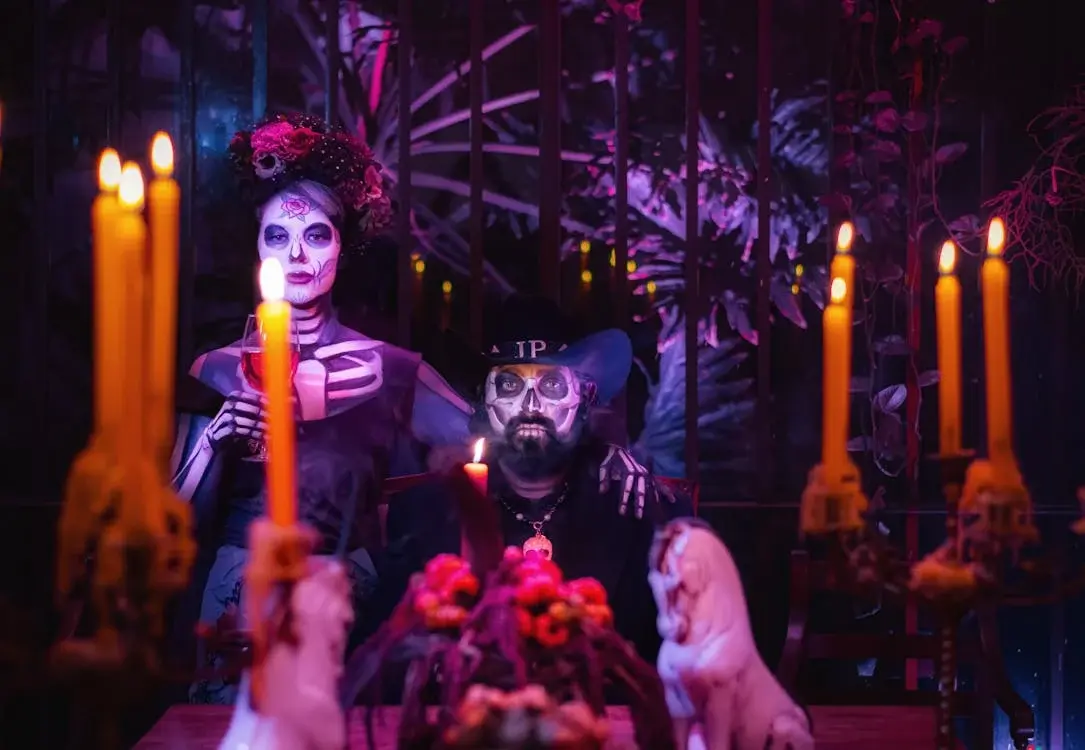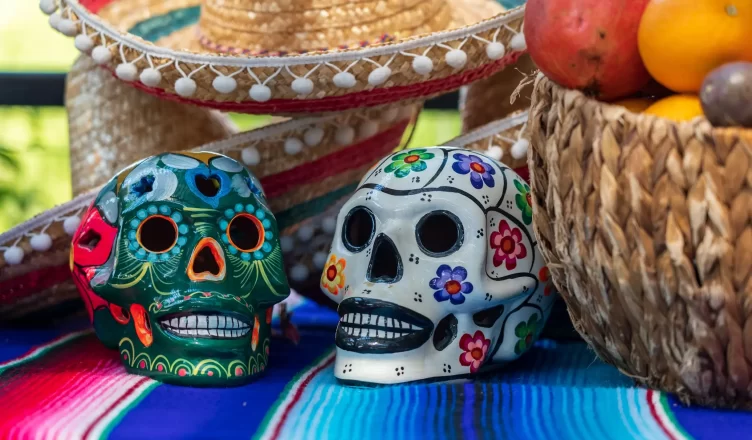The Day of the Dead (Día de los Muertos) is a Mexican holiday that honors deceased loved ones. Highlight its cultural importance and rich traditions, including altars (ofrendas), marigolds (cempasúchil), and sugar skulls (calaveritas de azúcar).
If you choose México as a travel destination at the end of October and the beginning of November, let us inform you that you have selected the best destination to celebrate and appreciate this beautiful Mexican tradition.
When is the Day of the Dead?
The Day of the Dead is a Mexican tradition celebrated on November 1st and 2nd each year. It honors loved ones who passed away by welcoming their spirits back for a joyful reunion.
It’s the most beautiful tradition in Mexico with many symbolisms in each of its decorations, colors, skulls, and elements.
As mentioned, the Day of the Dead takes place over two days to celebrate loved ones of all ages:
- November 1st (Día de los Inocentes): Honors deceased children, known as “angelitos” (little angels).
- November 2nd (Día de los Muertos): Honors adults who have passed away. Families visit cemeteries to clean and decorate the gravesites with flowers, candles, and the favorite foods of the departed.
Traditional Decorations
 Day of the Dead comes with a wide variety of decorations, elements, and colors. A key part of the decor is the altar, which can have multiple levels, each with a particular meaning. These levels represent the steps that the souls had to pass through. However, it’s important to note that there are also three-level altars, but here we explain the significance of each of the seven levels:
Day of the Dead comes with a wide variety of decorations, elements, and colors. A key part of the decor is the altar, which can have multiple levels, each with a particular meaning. These levels represent the steps that the souls had to pass through. However, it’s important to note that there are also three-level altars, but here we explain the significance of each of the seven levels:
- Level 1: This represents the Earth, the plane of the living, and is adorned with flower petals, ash, and a cross made of salt. These elements offer protection.
- Level 2: Water is the undeniable element here, meant to quench the thirst of the deceased, who makes a long journey to reach the Earth.
- Level 3: The elements placed here are “pan de muerto” (bread of the dead) and the favorite food that the deceased enjoyed in life.
- Level 4: This level represents the wind, and to symbolize it, “papel picado” (perforated paper) is placed. Its purpose is to allow the soul to connect with both the spiritual and earthly realms.
- Level 5: Flowers are placed in this space, mainly the iconic “cempasúchil” or marigold, whose orange color provides fragrance, color, and beauty.
- Level 6: Incense or “copal” should be placed here, as they help purify the air and offer good intentions.
- Level 7: The photo of the deceased and another religious image are placed here, symbolizing divine protection.
Altar Elements and Their Meaning
To properly set up an altar for the Day of the Dead, besides understanding the levels and their symbolism, it’s also crucial to know that each element placed on the altar holds special importance. As mentioned, Día de Muertos is a special day to honor our loved ones, and what better way to decorate the altar than with items they cherished in life?

1.- Add the photograph of the deceased:
This is one of the most important elements. Place it at the highest level of the altar, as it symbolizes an invitation for the spirit of your loved one to return and be remembered.
2.- Candles and votive candles
Candles represent the light that guides the spirits on their journey back to the world of the living.
3.- Marigold flowers (Cempasúchil):
Marigolds play an essential role in the decor. Their purpose is to mark the path so that the souls can find their way to the altars.
4.- Salt:
Salt is a symbol of purification and protects the souls during their visit to the world of the living, ensuring their safe return.
5.- Incense and copal:
These elements help ward off evil spirits, allowing the souls to safely enter their former homes.
6.- Petate (woven mat):
This is placed for the souls to rest or to set down the food from the offerings.
7.- Sugar or chocolate skulls:
These skulls are dedicated to the Holy Trinity, with the largest one representing the Eternal Father.
8.- Cross of ash or salt:
This serves to purify the souls when they arrive at the altar, helping them release any sins they carry.
9.- Personal items of the deceased:
Include belongings or objects that represent the loved one’s passions or personality, such as books, toys, or musical instruments, to make them feel welcome.
10.- Papel Picado (perforated paper):
This colorful, perforated tissue paper is commonly used for traditional Mexican festivities. The vibrant designs represent typical elements of the celebrations.
Colors Used in the Day of the Dead Altar
In addition to the important elements placed on the altar, Day of the Dead altars are also known for being quite colorful. Each color holds a specific meaning:
- Purple: Represents mourning and respect for the deceased, and is also connected to Catholic rites.
- Orange: Associated with the marigold flower (cempasúchil), it symbolizes light and pre-Hispanic mourning.
- White: Represents purity and hope.
- Black: Symbolizes Mictlán, the pre-Hispanic underworld, and death itself.
- Red: Linked to the blood of Christ and sacrifice, blending Catholic and indigenous beliefs.
How to Celebrate the Day of the Dead in Cancun
 If you plan to travel to Cancun during these dates, it’s very likely that the resort where you’re staying will host activities related to this tradition. However, here are some other places where you can fully enjoy this celebration:
If you plan to travel to Cancun during these dates, it’s very likely that the resort where you’re staying will host activities related to this tradition. However, here are some other places where you can fully enjoy this celebration:
Exhibition of Altars and Offerings
Every year, as is customary, altars are displayed in strategic locations throughout Cancun, such as Malecón Tajamar in front of Plaza Las Américas or at the Municipal Palace in downtown Cancun.
Festival of Life and Death Traditions at Xcaret
Xcaret also hosts the Festival of Life and Death Traditions, featuring artistic, pre-Hispanic, cultural, and culinary themes. This is one of the most anticipated events of the year for both locals and foreign tourists. The festival takes place from October 30 to November 2, aiming to preserve Mexican traditions and customs while offering an immersive cultural experience.
Hanal Pixan
Have you ever heard of “Hanal Pixan”? It is a Mayan tradition with the same concept of remembering loved ones who have passed away. Hanal Pixán means “food for the souls,” and is celebrated by offering food to the spirits.
This tradition is celebrated from October 31 to November 2, slightly differently from the Day of the Dead. One key difference is the inclusion of a green cross made from a plant in Hanal Pixán. Another significant element is the famous “Mucbipollo” or “Pibipollo,” a large tamal filled with pork, chicken, tomatoes, and chilies, wrapped in banana leaves and cooked for hours.
This year, on October 26, 2024, a parade will take place at 3:30 PM, starting from Faro Quintana Roo and ending at Parque La Paz, where family-friendly activities will be held.

